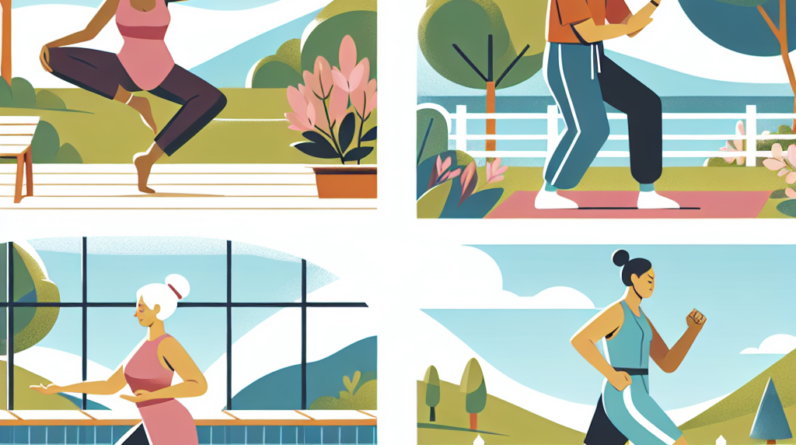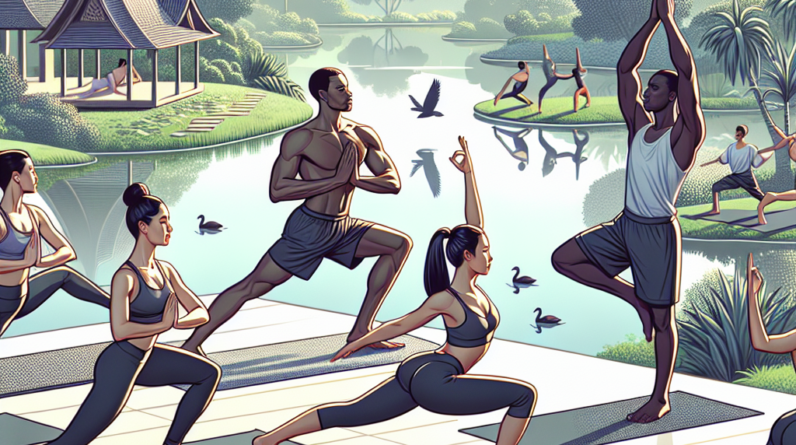
Gentle Stretching Exercises
Why Stretching is Important
Hey there! Let me tell you, stretching is a game changer, especially as we age. It helps to maintain flexibility, which can really become a challenge when you’re not as spry as you used to be. I remember the first time I tried stretching after a long break – I felt like a rusty hinge creaking! But with regular stretching, I cranked up the oil and felt so much better.
Get a Huge Discount and Bonus! Try for 90 Days Risk Free
Not only does stretching keep those muscles limber, but it also promotes blood flow throughout the body. This is particularly crucial for seniors, as good circulation plays a key role in preventing injuries. By taking just a few minutes daily to stretch, you’re investing in your mobility. Seriously, it’s like putting a little maintenance in that old car of yours!
So grab a mat, or just find a comfy spot in your living room. You don’t need to be a yoga master; a few simple stretches can do wonders. Try reaching for your toes, or giving your arms a nice overhead stretch. It feels fantastic, I promise!
Simple Stretching Techniques
Let’s dive into a couple of easy stretches that can really make a difference. One of my go-to moves is the neck stretch. Just gently tilt your head to each side, holding it for a few seconds each. You’ll love how it loosens up all those tight muscles from hunching over the TV or our phones.
Another favorite of mine is the seated hamstring stretch. Sit on the edge of your chair and slowly extend one leg out straight, resting your heel on the floor. Lean slightly forward until you feel a gentle pull along the back of your thigh. It’s so satisfying to see how far you can reach with time!
Remember, stretching shouldn’t be painful. If you feel sharp pain, dial it back a notch. It’s all about easing into it, and with time, you’ll find yourself bending and stretching like a pro.
Incorporating Stretching into Your Day
It’s super easy to fit stretching into your daily routine. I like to stretch first thing in the morning, right after I roll out of bed. It wakes me up and gets my blood pumping! Stretching while watching your favorite daytime show is another great way to get it done, too.
Even when you’re out and about – like at the grocery store or in a waiting room – try doing wrist and ankle rotations discreetly. Who says we can’t sneak in a little bit of exercise no matter where we are?
Remember, consistency is key! The more you make stretching a regular part of your day, the more you’ll benefit from it, and before you know it, you’ll be moving with newfound grace and ease.
Get a Huge Discount and Bonus! Try for 90 Days Risk Free
Water Aerobics
Benefits of Water Aerobics
Let’s talk about one of my favorite low-impact exercises: water aerobics! There’s something about being in the water that feels refreshing and liberating. It’s perfect for seniors, as the buoyancy reduces impact on joints while still providing a great workout. I can’t imagine a better way to exercise than splashing around while getting fit!
Water also offers natural resistance, making those movements beneficial for building strength. Trust me when I say that those simple exercises become more challenging when you’re in water. Plus, it’s often much cooler than an indoor gym in summer – you might find it’s a nice escape!
Many local community centers offer water aerobics classes tailored specifically for seniors, and I highly recommend giving one a try. You’ll find camaraderie among participants, and it can be a real blast having fun with friends!
What to Expect in a Class
When you join a class, get ready for a mix of cardio and strength exercises, all while floating! The instructor will usually guide you through a series of moves, such as leg lifts, arm circles, and even some dancing in the water. Doesn’t that sound fun? I guarantee you can bust a move while also toning up!
Need a Serious Energy BOOST? Huge Discount Try for 90 Days Risk Free
The best part? If you’re struggling with any movements, the water allows for a bit of grace — if you lose your balance, you won’t fall! You’ll just float for a moment. How awesome is that?
Each class might vary; sometimes they’ll use noodles or water weights to add a little bit more pizzazz to the workout. So, trust me, you won’t get bored doing water aerobics!
Safety Tips for Water Aerobics
While water aerobics is generally super safe, it’s always a good idea to take some precautions. Make sure to choose a pool with warm water, as that can help keep your muscles relaxed. When you arrive, take a moment to test the depth before jumping in. I’ve learned that lesson the hard way!
If you’re new to exercising or have any health concerns, definitely chat with your doctor before getting started. They can provide specific recommendations or modifications. Safety first, my friends!
Lastly, stay hydrated! It’s easy to forget, but just because you’re in the water doesn’t mean you shouldn’t drink water throughout your workout. Trust me; your body will thank you later!
Chair Yoga
Introduction to Chair Yoga
If you’re looking for a way to unwind while still getting a bit of exercise, chair yoga could be the perfect match for you! This practice is a gentle form of yoga that uses the chair for support. I’ve found it particularly helpful for achieving relaxation and balance, and it’s suitable for all fitness levels.
Chair yoga allows you to stretch and strengthen your body without needing to get up and down from the floor. You may just be amazed at how flexible you can become with a little practice. Plus, you can do it at home or in your favorite local community center — talk about convenience!
Each pose can improve your flexibility, increase circulation, and even lower stress levels. Honestly, it feels fantastic to simply breathe deeply and stretch. It’s like a mini-vacation for your body!
Basic Chair Yoga Poses
Alright, I’ll share a few basic poses to help you get started! One of my go-to poses is the seated forward bend. While sitting, reach your arms up, then gently fold forward with a straight back. It’s a great stretch for your back and hamstrings.
Another favorite is the seated twist. Just sit tall in your chair and slowly twist your torso to one side, holding onto the chair’s armrest for support. This helps with spinal mobility and digestion — no more pesky upset tummies!
Remember to take it slow and listen to your body. If something doesn’t feel right, skip it. The beauty of chair yoga is that you can make it your own, and even as a beginner, you’ll quickly find your rhythm!
Creating a Comfortable Space
To get the most out of your chair yoga practice, set up a cozy space at home. Find a chair that is comfortable and stable; it shouldn’t be too squishy or wobbly. I also love to dim the lights and play some soft music or nature sounds while I stretch. It sets such a calming atmosphere!
Good Health Solution is Easier Than Most People Think!
Take a Look for Yourself!
Wearing comfy clothes is key, too. You want to be able to move without feeling constricted. I often throw on a pair of stretchy pants and a loose t-shirt, and I’m ready to roll!
And don’t forget about your breath. Inhale deeply through your nose and exhale through your mouth. This really enhances the yoga experience and helps to focus your mind. Grab your chair, find your zen, and enjoy!
Walking Groups
The Benefits of Walking
Walking is one of the easiest low-impact exercises you can do, and it’s something that just about everyone can enjoy. I’ve started to love taking strolls, whether it’s around my neighborhood or at a beautiful park. Not only is it great for your physical health, but it does wonders for your mental wellbeing, too!
Regular walks can improve cardiovascular health, boost mood, and even help maintain a healthy weight. Plus, it’s a perfect way to enjoy some fresh air and sunshine (with sunscreen, of course!). In my book, that’s a terrific way to get fit!
Walking is also a friendly activity – it’s easy to do alone, but it’s even better with friends. So grab a buddy and turn your stroll into a social event. I guarantee you’ll have a laugh or two while getting your steps in!
Joining or Forming a Walking Group
Finding a walking group in your community can be a fantastic way to stay motivated! Many communities offer organized walking groups that cater to all fitness levels. They’re filled with like-minded people who just want to enjoy some good conversation while staying active. What could be better than companionship and cardio?
If you can’t find a local group, why not start your own? It’s super easy—just invite friends or neighbors. Set a day and time to meet regularly, and watch your group grow!
Make sure to choose varied routes; this can keep things exciting. If you can find a local beautifying trail, you honestly might look forward to each walk!
Staying Safe While Walking
Although walking is low-impact, it’s still essential to be aware of your surroundings. Choose well-lit paths and, if possible, walk with a partner or group. I always feel safer and more motivated when I walk with others.
Wear comfortable, supportive walking shoes to prevent any blisters, and dress appropriately for the weather. Trust me; a rainy day isn’t an excuse to skip your walk! Just throw on a raincoat and embrace the adventure.
Lastly, don’t hesitate to take breaks whenever needed. Listen to your body; if you need to slow down or grab a sip of water, just do it. The goal is to enjoy the journey, not to rush through it!
Strength Training with Light Weights
The Importance of Strength Training
Okay, let’s chat about strength training! Many folks think lifting weights is only for the young and super fit, but that’s so not true. Strength training is vital for seniors because it helps maintain muscle mass and bone density as we age. I started incorporating light weights into my routine, and it’s been a game changer!
By using lighter weights or resistance bands, you can still build strength without putting too much stress on your joints. Plus, gaining muscle can help with balance and prevent falls—such a big deal as we get older!
Even just a couple of short sessions each week can significantly improve your overall strength and stamina. I’ve been able to lift my grocery bags without straining my back, and it feels amazing!
Getting Started with Light Weights
It doesn’t take much to get started with strength training. Find some light dumbbells, resistance bands, or even a couple of cans from your pantry if that’s what you have! Start with simple exercises like bicep curls or over-the-head presses. It’s crazy how much you can feel the burn without going heavy!
One of my favorites is the chair stand: sit on the edge of your chair and rise to a standing position, then sit back down. Get those reps in while building strength in your legs and improving your balance.
I always suggest starting out with just 5-10 minutes, focusing on form rather than speed. You want those muscles to be activated, so take your time to avoid injury. Progress is progress, no matter how small it may seem!
Incorporating Strength Training into Your Routine
To make strength training a habit, I usually pick a specific day and time for my workouts. Consistency is key, folks! Just like you might have a routine for your morning coffee, make your workouts a regular part of your week.
Consider adding strength training sessions after posts or other activities, such as walking or stretching. Combine different exercises to keep things interesting: increase reps as your strength improves. You’ll surprise yourself with what you can achieve!
Lastly, don’t forget to celebrate your achievements! Every little bit counts. Whether that’s lifting a bit heavier, doing another rep, or just feeling stronger overall, give yourself a pat on the back—because you deserve it!
FAQ
1. What are the benefits of low-impact exercises for seniors?
Low-impact exercises help improve mobility, reduce the risk of injury, and promote overall fitness without putting too much stress on the joints. They also enhance cardiovascular health and can boost mood.
2. How often should seniors engage in low-impact exercises?
It’s generally recommended for seniors to aim for at least 150 minutes of moderate-intensity exercise each week. This can be spread across several days, including a mix of different activities like stretching, walking, and strength training.
3. Do I need to be fit to start low-impact exercises?
Nope! Low-impact exercises are suitable for all fitness levels, including beginners. Just start slow, listen to your body, and gradually build up your endurance and strength.
4. What is the best low-impact exercise for arthritis?
Water aerobics and gentle stretching are both excellent choices for individuals with arthritis. The buoyancy of water eases pressure on joints, while stretching helps maintain flexibility and reduces stiffness.
5. Can I do low-impact exercises at home?
Absolutely! Many low-impact exercises can be performed at home, like stretching, chair yoga, and light weights. You can even follow online videos to guide you through your workouts at your own pace!








